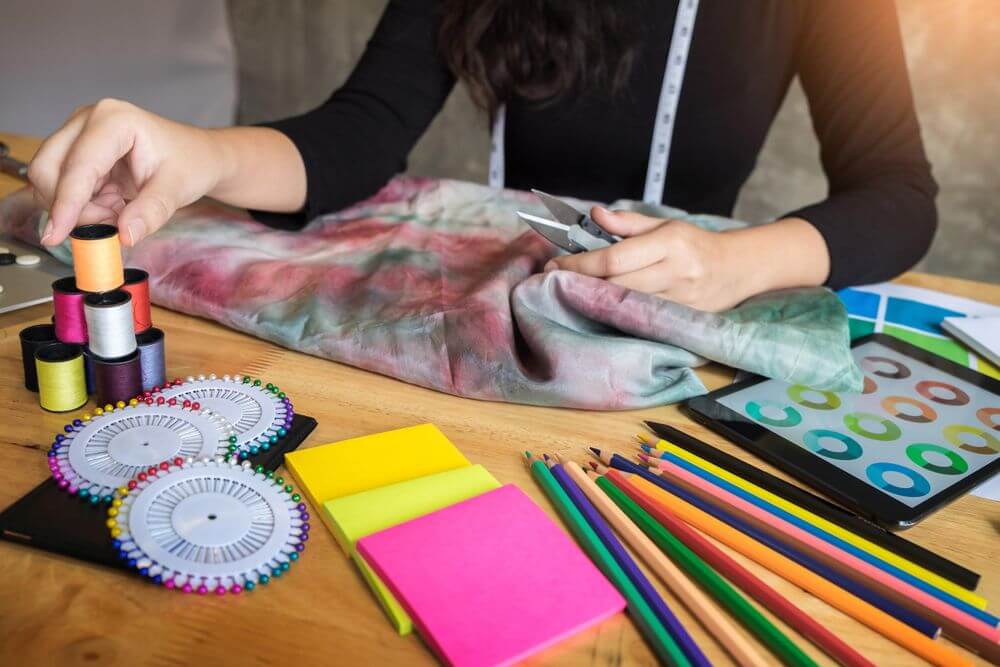Working tightly with fashion designers and design departments, a textile designer generates an original rough draft of what the designer has in mind for any particular garment. Independent developers who are just starting may produce their designs. They generally work with a team of pattern manufacturers if they are set up or work for big businesses.
These professionals are also known as pattern designers. Designing patterns for woven, knitted, or printed fabrics with or without ornamentation on their surface is the essence of textile design.
They are engaged in the manufacturing of these models that are used in clothing and interior decoration products, sometimes repeatedly.

Types of Jobs for a Textile Designer
They produce patterns and designs for fabrics produced from natural and human-made fibers that are knitted, printed, and woven. They choose which textile fibers to weave into a textile and what patterns to create.
There are many distinct sectors, including fashion, art, and technology. For home products and the apparel or clothing industry, there are two prevalent kinds of textile design. In developing textiles and printed patterns for high fashion or more affordable ready-to-wear styles, some designers work with fashion designers.
Different types of designs fall under the three categories. These designs may vary depending on various factors.
- Conversational Pattern. Conversational patterns are sometimes referred to as novelty prints and contain pictures of objects or situations. The inspiration of the artist is not always immediately visible in these designs until carefully examined.
- Abstract Pattern. Abstract patterns are not representational designs, with shapes and patterns freely drawn.
- Retro Pattern. Retro patterns are designs inspired by or seeking to emulate the style of a past era. They do this by using a mixture of their color and pattern features or by referring to the period’s illustrative style.
- Geometrical Pattern. Textile designers create shape patterns in the fabric.
- Organic Pattern. Organic patterns depict the natural forms of flora and fauna and fall into what is deemed to be the design category’s most common.
Average Pay for a Textile Designer
According to Fashion Schools, textile designers typically receive as low as $19,000 and up to $85,000 or more on the high end, depending on the kind of business and its size, experience, geographic place, and education.
However, according to Payscale, with five to nine years of experience, a mid-career textile designer can expect to make an average annual salary of $61,753 (based on 100 salaries). A seasoned textile designer with between ten and nineteen years of experience makes an average total compensation of $66,349 yearly (based on 67 salaries).
Where to Find Jobs as a Textile Designer
Textile designers work for fashion designers, retail companies, textile companies, design studios, and other manufacturing facilities. Some textile designers are self-employed, so they might work for multiple clients at a time.
Textile designers can start their own businesses. However, in case you are looking for a day or regular work, here are several websites you might check out.
- Indeed – Indeed is a popular job search platform as it is. Check out this site for open positions.
- Glassdoor – Glassdoor is another well-known job search platform. Click here for job openings.
- Naukri Gulf – Naukri Gulf is a popular job search website in UAE.
How to Apply for a Job as a Textile Designer
Some textile designers have their own businesses. However, you can also take up a course that relates to fashion and fabric. You can get a bachelor’s degree in textile design, graphic design, or a fashion-related field. This is often required to apply for a position as a textile designer.
You can also submit an internship application. Complete your internship program with your chosen fashion company. During your course, it is best to seek skills in Adobe Suites.
To become a textile designer, you must have the following skills, as well.
- Good sense of color
- Awareness of current trends in fabrics and fashion
- Creativity
Join an organization. Joining a professional organization like America’s Textile Society can be useful to a designer just beginning in the field.
Conclusion
Before becoming a textile designer, you must show love for passion and style. Gain experience in the field and get to know more people in the industry. Being a textile designer has a lot of perks waiting for you, including traveling, meeting new people, working with the most prominent fashion icons, and more.
For another fashion career, click here for more information.
Also read – How to Advertise Your New Tailoring Business
